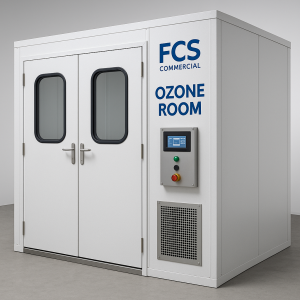- Deodorising clothing
Unpleasant odours clinging to costumes after rehearsals, performances and travel can be a significant challenge for theatre and film studios. Sweat, smoke, and other lingering smells can be difficult to remove, potentially impacting the overall production and even the health and well-being of actors.
Ozone effectively neutralises odour-causing bacteria and molecules, leaving garments fresh and clean. Ozone applications in film studios include the use of innovative Ozone Cabinets, which can be programmed to effectively remove odour from clothing in bulk. Ozone Cabinets are ideal for delicate garments and props that cannot be safely cleaned using traditional methods.
- Improving indoor air quality in hotels
First impressions are crucial in the hospitality industry. Guests expect a pristine and inviting environment upon entering their hotel room. Ozone technology offers an efficient and effective solution to enhance your room turnover process and provide a fresh, clean smell.
By utilising Ozone applications, rooms can be treated and readied for the next guest within 20 minutes, minimising downtime.
Beyond eliminating unpleasant odours, Ozone is effective at destroying bacteria present on high-touch surfaces such as doorknobs, light switches, and remote controls, significantly reducing the risk of cross-contamination.
Ozone can effectively inactivate airborne bacteria and viruses, reducing the risk of infection and promoting a healthier environment.
- Preventing the spread of viruses in healthcare settings
Healthcare settings, including care homes, are particularly susceptible to the rapid spread of viruses and other pathogens.
Ozone applications can enhance infection control protocols within these environments.
By circulating Ozone through the air, it can effectively neutralise airborne pathogens, reducing the risk of respiratory infections among residents and staff.
This is particularly pertinent during the winter months and flu season, when opening windows is not a viable option due to cold temperatures.
Ozone can help to bring the freshness of the outdoors inside.
- Reducing allergens in residential settings
In shared living spaces such as Airbnb rentals and student housing, allergens like dust mites, pet dander, and mould spores can trigger allergic reactions and respiratory issues.
Ozone can effectively eliminate these allergens, improving indoor air quality and creating a healthier living environment for people with allergies and sensitivities.
Ozone applications can be used to supplement traditional cleaning methods, improving the overall cleanliness and hygiene of shared spaces.
By incorporating Ozone technology into their cleaning and maintenance routines, property owners and managers of Airbnb rentals and student housing can enhance the safety and well-being of their occupants, create a more hygienic environment, and improve overall guest satisfaction.
- Improving commercial washroom hygiene
Ozone applications are a highly effective solution for combatting persistent odours in commercial bathrooms. Unlike traditional masking agents that merely cover up unpleasant smells, Ozone actively neutralises odour molecules at their source. By breaking down odour-causing compounds, Ozone can eradicate the problem, leaving behind a fresh and clean environment. This not only improves the overall hygiene and comfort for bathroom users but also enhances the overall impression of the facility, creating a more positive and welcoming atmosphere for customers and employees.
Wall-mounted and ceiling-mounted Ozone generators are available for a discreet and space-saving solution.
- Supporting mould remediation
Mould remediation is the process of eliminating mould growth and preventing its recurrence.
The presence of mould in residential and commercial settings can pose significant health risks to building occupants. Ozone is a strong oxidiser that can kill mould spores and mycelia, inhibiting its growth. It can also effectively remove the musty odours associated with mould.
Ozone generators are particularly useful during the containment and removal process in mould remediation work, ensuring that workers are not breathing in harmful spores.
Ozone can penetrate deep into surfaces and materials, reaching mould in areas that may be difficult to clean or remove manually.
